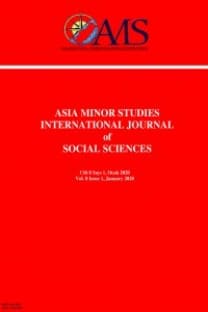Western Women as Subject in Orientalist Texts: An Example of Lady Montagu’s Turkish Embassy Letters
Batı'nın Doğu hakkındaki imajları ya da söylemlerini içeren Oryantalizm seyahat metinleri, edebiyat eserleri, bilimsel çalışmalar gibi birçok alanda örneklerini görebileceğimiz bir alandır. Oryantalist metinlerde en çok kullanılan imajlardan biri kadın ve onun yer aldığı harem, hamam, köle pazarı gibi mekanlardır. Çoğunlukla Avrupalı erkekler tarafından üretilen Oryantalist metinlerde kadın ve onun içinde bulunduğu mekanlar Batılı erkeklerin arzularına cevap verecek şekilde sembolleştirilir ve ortaya Batılı erkek-öznenin gözünden çizilen bir Doğu anlatısı koleksiyonu çıkar. Batılı kadın seyyahlar da daha sonra Doğu'ya seyahat ederek Batılı-erkek bakışın metinlerinden ayrışan ve kadın-bakışını yansıtan eserler ortaya koyarlar. Bu çalışmada Bu çalışmada, 1717-1718 yılında İstanbul'da bulunan Lady Worthley Montagu'ya ait Türkiye Mektupları kitabı ele alınıp incelenecek ve Batılı kadın ve erkek öznelerin Doğulu kadına bakışındaki benzerlikler ve farklılıklar gösterilecektir.
Oryantalist Metinlerde Özne Olarak Batılı Kadın: Lady Montagu’nun Türkiye Mektupları Örneği
Orientalism, which includes the West's images or discourses about the East, is an area where we can see examples in many fields such as travel books, literary works, or scientific studies. One of the most used images in orientalist texts is the woman and harem, bathhouse, slave market. In Orientalist texts, mostly produced by European men, women and their places are symbolized in a way that responds to Western men's desires, and a collection of Eastern narratives drawn through the eyes of the Western male-subject emerges. The Western women later travel to the East, creating works that differ from the Western-male perspective and reflect the female-gaze. In this study, the book Turkish Embassy Letters by Lady Worthley Montagu, who was in Istanbul between 1717-1718, will be scrutinized and the similarities and differences between Western female and male subjects given Eastern women will be shown.
Keywords:
Orientalism, Edward Said, Lady Montagu, woman narration, letter travel texts,
___
Bulut, Y. (2016). Oryantalizmin kısa tarihi. İstanbul: Küre Yayınları.Cavaliero, R. (2010). Ottomania: The Romantics and the myth of the Islamic Orient. NY: I.B.Tauris
De Groot, J. (1989). Sex and race: The construction of language and image in the nineteenth century. In S. Mendus and J. Rendall (Eds.), Sexuality and subordination, 89-128: NY: Routledge.
Derrida, J. (1977). Of grammatology. (G. C. Spivak, trans.) London: John Hopkins University Press
Foucault, M. (1978). The history of sexuality vol. 1: An introduction. (R. Hurley, trans.) New York: Pantheon Books.
Hugo, V. (2012). Les Orientales. US: Nabu Press.
Kennedy, V. (2019). Edward Said and resistance in colonial and postcolonial literatures. In G. Nash (Eds.), Orientalism and literature, 219-234: Cambridge, UK: Cambridge University Press
Lewis, B. (1993). Islam and the West. NY: Oxford University Press.
Lewis, R. (2004). Rethinking Orientalism: women, travel and the Ottoman harem. London: I.B. Tauris.
Melman, B. (1992). Women's Orients: English women and the Middle East, 1718-1918: sexuality, religion and work. Ann Arbor: University of Michigan Press.
Montagu, M. W. (1992). Letters. NY: Everyman’s Library.
Said, E. D. (1979). Orientalism. London: Penguin Books.
Schick, I. C. (2000). Batı’nın cinsel kıyısı: Başkalıkçı söylemde cinsellik ve mekansallık. İstanbul: Tarih Vakfı Yurt Yayınları.
Yeğenoğlu, M. (1998). Colonial fantasies: Towards a feminist reading of Orientalism. Cambridge: Cambridge University Press
- ISSN: 2147-1673
- Yayın Aralığı: Yılda 2 Sayı
- Başlangıç: 2013
- Yayıncı: Serhat KUZUCU
Sayıdaki Diğer Makaleler
Halk Anlatılarına Göre Kilis’te İlginç İnanışlar ve Olaylar
Western Women as Subject in Orientalist Texts: An Example of Lady Montagu’s Turkish Embassy Letters
Emirdağ İlçesinde Yaşayanları Göçe Zorlayan Temel Sebepler
Cephe Tasarımında Sembolizm ve İsmailiye Sarayı Cephesindeki Değişim Süreci
Didem ERTEN BİLGİÇ, Zeyneb TAHİRLİ
Özbek Masallarında Halk Hekimliği Uygulamaları
Asker Anıları Işığında İkinci Dünya Savaşı Türkiye'si
